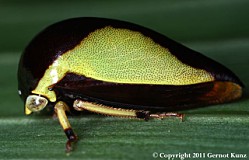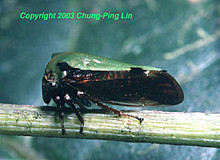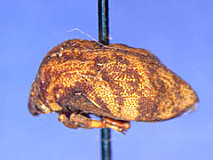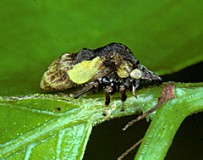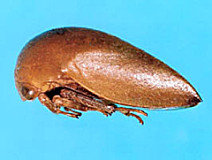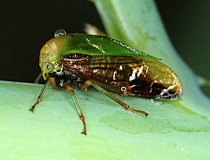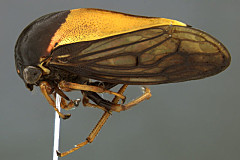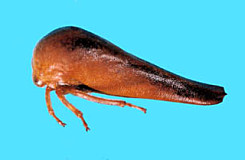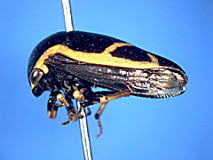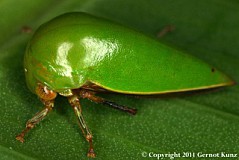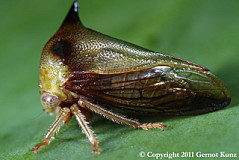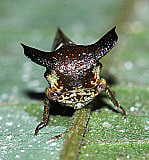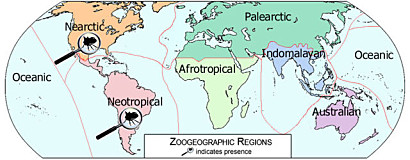Amyot and Serville 1843a
Funkhouser 1951a
Metcalf and Wade 1965a
Deitz 1975a
McKamey 1998a
Roy 2003a
Godoy, Miranda, and Nishida 2006a
Roy, Guilbert, and Bourgoin 2007a
Wallace 2010a
Gonzalez-Mozo et al. 2017a
McKamey and Sullivan-Beckers 2019a
Flórez-V. and Evangelista, 2022a
Gonzalez-Mozo and Ware 2023a
Animalia → Arthropoda → Insecta → Pterygota → Hemiptera → Auchenorrhyncha → Cicadomorpha → Membracoidea → Membracidae → Darninae
Darnini Amyot and Serville, 1843
Selected references
Overview
Deitz (1975a) presented an overview of the Darninae that includes a detailed illustrated description of the subfamily and each of its five tribes (one which was new), as well as a key to these tribes. Members of the tribe Darnini fall into three pronotal forms related to various mimetic strategies (Roy et al. 2007; Gonzalez-Mozo and Ware 2023a): (1) ‘dew- or raindrops,’ (2) ‘thorns,’ and (3) ‘bird droppings’. Group 1, the “raindrop” mimetic strategy refers to genera that resemble a drop of water in shape—the pronotum is smoothly convex and lacks horns, but covers the wings laterally as in the genera Alobia, Darnis, Dectonura, Hebetica, Hebeticoides, Leptosticta, Ochrolomia, Peltosticta, and Stictopelta. Group 2, the ‘thorny’ genera include Alcmeone and Sundarion in which the pronotum is smooth and regular, but has well developed suprahumeral horns laterally. In group 3, the ‘bird droppings” genera, the pronotum is rugose, irregular, sometimes swollen preapically, generally giving the insect the appearance of bird manure on a plant. In these genera, the pronotum usually lacks horns, but covers most of the wings laterally: Allocyphotes, Aspona, Cyphotes, Hypheodana, Nasuconia and Taunaya. Gonzalez-Mozo and Ware 2023a provided illustrations of the three genus-groups within Darnini, as well as a key to identifying the genera in the “bird dropping” group.
Taxon history
In Metcalf and Wade’s (1965) catalogue the subfamily Darnini consisted of the tribes included the tribes Darnini, Cymbomorphini, Aconophorini, hemiktypthini, and Heteronotini, Deitz (1975a) refined the subfamily Darninae, limiting the it to the tribes Cymbomorphini, Darnini, Hyphinoini, Hemikypthini, and a new tribe Procyrtini, while placing Heteronotini in a separate subfamily (Heteronotini), and referring Aconophorini to the subfamily Membracinae.
Taxon images
Darnini
Distribution
Neotropical and Nearctic regions. South and Central America north through Mexico into southwestern United States. Recently, McKamey and Sullivan-Beckers (2019a) described a new species of Hebetica from the eastern US (Kentucky).
Diagnostic characters
Forewings in repose entirely exposed or partially concealed by pronotum. Pro- and mesothoracic femora usually with longitudinal row of cucullate setae ventrally, apposing 1 or 2 similar rows of tibal setae. Metathoracic coxa and trochanter unarmed, femur usually with longitudinal rows of cucullate setae (exceptions: Aspona, Cyphotes, and Taunaya), tibia with 3 longitudinal rows of cucullate setae (exceptions: some Aspona and Alobia without row I). Abdomen with or without conspicuous pits ventrally.
Description
See Deitz (1975a) for a description of this tribe.
Behavior
Members of the tribe Darnini are thought be solitary as adults and nymphs, do not exhibit parent of care, and are not associated with tending ants or bees (Gonzalez-Mozo et al. 2017a).
Taxonomic constituents
Alcmeone Stål, 1867 Stål, 1867
Allocyphotes Gonzalez-Mozo in Gonzalez-Mozo and Ware, 2023 Gonzalez-Mozo in Gonzalez-Mozo and Ware, 2023
Alobia Stål, 1869 Stål, 1869
Andinodarnis Flórez-V. and Evangelista, 2022 Flórez-V. and Evangelista, 2022
Aspona Stål, 1862 Stål, 1862
Cyphotes Burmeister, 1835 Burmeister, 1835
Darnis Fabricius, 1803 Fabricius, 1803
Dectonura Butler, 1878 Butler, 1878
Hebetica Stål, 1869 Stål, 1869
Hebeticoides Fowler, 1894 Fowler, 1894
Hypheodana Metcalf, 1952 Metcalf, 1952
Leptosticta Stål, 1869 Stål, 1869
Nasuconia Sakakibara, 2007 Sakakibara, 2007
Ochrolomia Stål, 1869 Stål, 1869
Peltosticta Sakakibara, 1976 Sakakibara, 1976
Polyodontotrochus González-Mozo and McKamey, 2024 González-Mozo and McKamey, 2024
Stictopelta Stål, 1869 Stål, 1869
Sundarion Kirkaldy, 1904 Kirkaldy, 1904
Taunaya Fonseca, 1934 Fonseca, 1934
Prepared by
Lewis L. Deitz, Stuart H. McKamey, Matthew S. Wallace, and Mark J. Rothschild, 14 February 2024.


